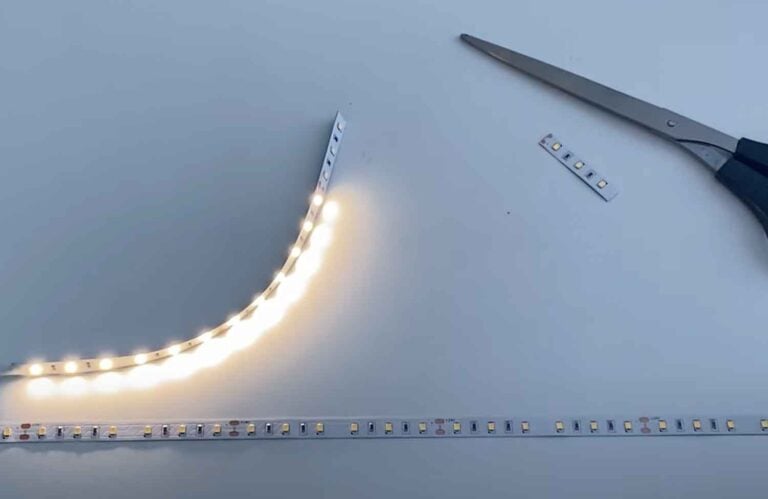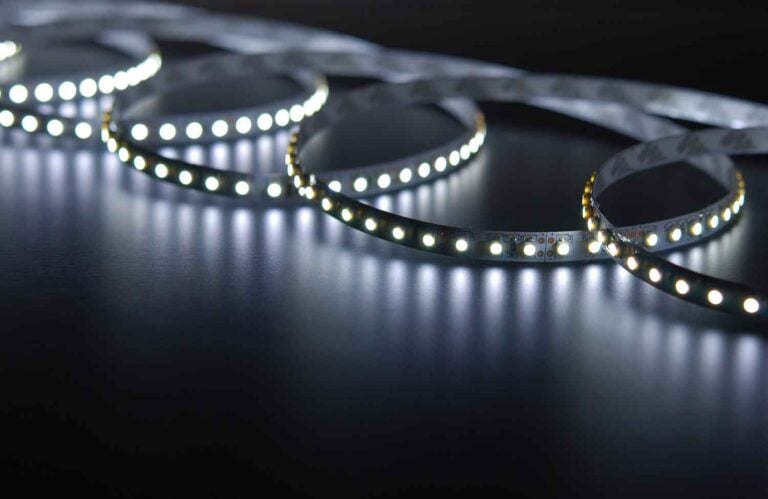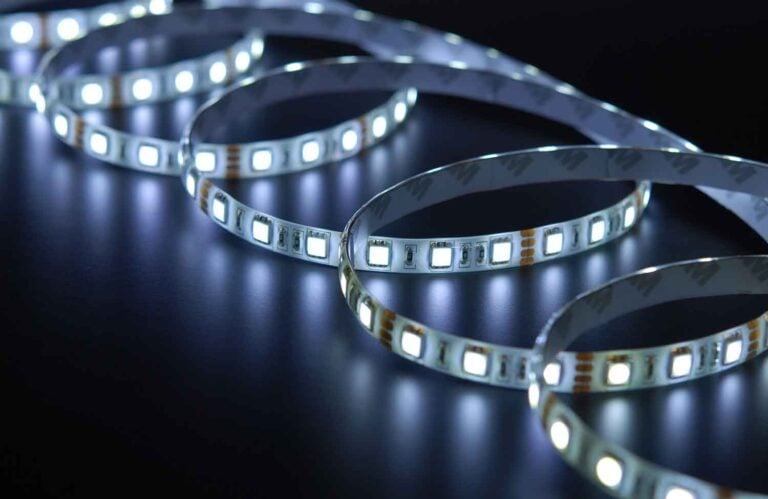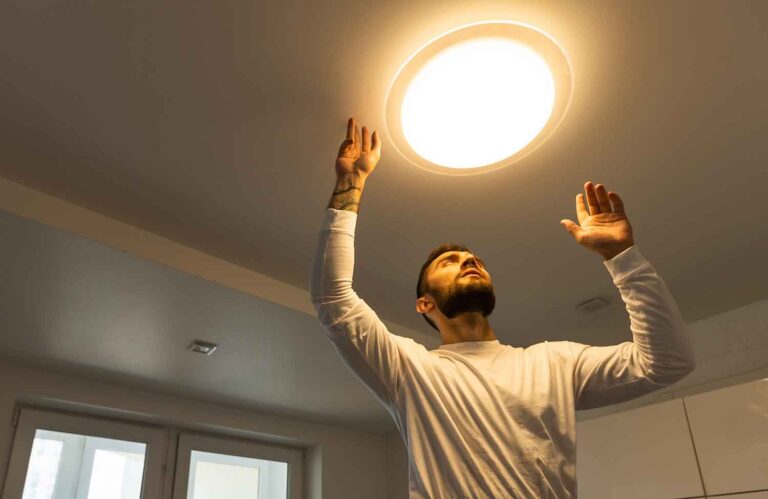Can You Sleep With LED Strip Lights On?
The lighting in a room can have a significant influence on your perception of that environment. With the ability to customise the brightness and colour of their light, LED strip lights are a popular choice for bedrooms; these fixtures allow you to tailor the ambience of your room to your liking. This understandably leads to the concern of whether there are health or safety risks associated with sleeping with LED lights on.
Yes, you can sleep with LED strip lights on, but this doesn’t mean you should. Safety-wise, there are no issues raised by sleeping with LED lights on; you can leave LED fixtures on 24/7 without creating a fire hazard as they generate little heat when lit. However, in terms of your health, sleeping with LED strip lights on in the same room is not a practice without its risks. Using LEDs at night can negatively impact the quality of your sleep in a number of ways, making it harder to fall and stay asleep.
Can You Sleep With LED Strip Lights On?
Yes, you can sleep with LED strip lights on. However, you should be aware that sleeping with LED strip lights on can negatively impact your sleeping habits. Also, aside from these health concerns, sleeping with LED strip lights on is an unnecessary waste of electricity.
Research shows that LED light can affect hormones and functions in your brain that control your sleep-wake cycle. Using LED lights at night can prolong the time it takes for you to fall asleep, decrease the quality of sleep you have, or prevent you from sleeping at all.
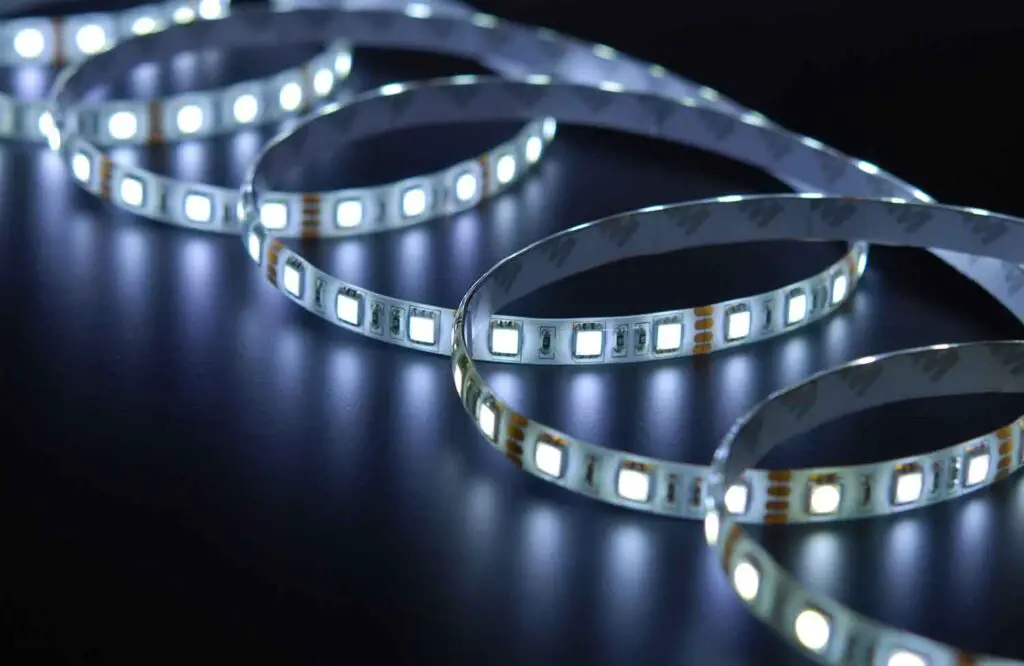
We explain all of the ways LED lighting can affect your sleep in more detail later in the article; we’ve also provided tips on how to minimise the impact that LED lights have on your sleep if you must use them at night.
You should also keep in mind that leaving your LED lights on overnight is an unnecessary waste of electricity. Theoretically, it is possible to leave LED lights on 24/7; LED bulbs generate very little heat when lit and therefore pose little to no safety risk if they’re on constantly. Despite this, you must still be mindful that powering your LED lights while you’re sleeping is a wasteful practice. You will incur greater costs on your electricity bills while also contributing negatively to your home’s carbon footprint.
Why is it Bad to Sleep With LED Strip Lights On?
1. LED Strip Lights Can Decrease Your Melatonin Levels
Exposure to LED lights during the night can decrease your brain’s production of melatonin. Melatonin is the hormone that controls your sleep-wake cycle; by decreasing the levels of this hormone in your brain, LED lights can make it difficult to fall asleep and stay asleep during the night.
To provide a bit of scientific context, hormones control our bodily functions and drive our moods and behaviours. Our brains have evolved to release certain hormones in response to external stimuli that we perceive with our senses. One such hormone is melatonin; secreted by a gland in the brain called the pineal gland, this hormone regulates our internal clock and sleep-wake cycle. Another term for this bodily function is our circadian rhythm.
When your brain detects sunlight, it suppresses the release of melatonin to keep you awake during the day. Oppositely, when your brain detects darkness upon nightfall, it gradually increases the production of melatonin; this sends a signal to the brain which stimulates a set of neurons that then cause you to feel sleepy. This cycle is therefore dependent on how much light your eyes perceive throughout the day.
Certain types of light, such as LED lights, can trick your brain into thinking it’s the daytime. Using your LEDs at night or sleeping with LED lights on can therefore impact your circadian rhythm; your brain perceives the LED light as sunlight and responds by suppressing the release of melatonin. Moreover, your brain is most sensitive to detecting light levels in the hours leading up to bedtime. Using LED strip lights during these hours can either delay your sleep cycle or prevent you from falling asleep at all.
2. LED Strip Lights Can Prolong Time it Takes to Get to Sleep
Following the previous point, LED strip lights can prolong the time it takes for you to get to sleep. Another term for this is your sleep latency; i.e. the amount of time in minutes that it takes to fall asleep after getting into bed.
Sleep latency offers an objective measure to determine the quality of sleep you’re getting. For instance, for someone with a regular sleep latency, it will take about 10 to 20 minutes to fall asleep. A shorter sleep latency of fewer than 8 minutes indicates that the person may have a sleep disorder causing increased sleepiness. A longer latency of greater than 20 minutes instead indicates the person has a disorder preventing the initiation of sleep.
Research shows that being exposed to artificial lights at night can prolong sleep latency. This means that if you attempt to sleep with LED strip lights on, it may take longer to fall asleep. LED lights have a tendency to disrupt your circadian rhythm, suppress your melatonin production, and increase your general alertness; all of these mental effects will make it much harder for you to go to sleep at your usual bedtime.
3. LED Strip Lights Can Decrease Periods of REM Sleep
Sleeping with LED strip lights on can decrease your periods of REM sleep throughout the night. This will negatively impact the overall quality of your sleep, making you feel sleepier during the day that follows.
When you’re asleep, your brain cycles between two different types of sleep, or ‘phases’; you’re either experiencing non-REM or REM sleep. REM stands for Rapid Eye Movement due to the tendency for the eyes to move rapidly during this period. Upon first falling asleep, you begin with a non-REM phase. This is a type of sleep in which you’re transitioning between wakefulness and unconsciousness.
Roughly 90 minutes after falling asleep, you then enter the REM phase. In this phase, your brain activity starts to fire up again. Your eyes move rapidly, your heart rate increases, your breathing becomes irregular, and you have dreams. This phase lasts around 10 minutes, then occurs in intervals throughout the rest of the duration of your sleep.
Periods of REM sleep are essential for the healthy development of your brain. You need REM sleep to support your mind’s emotional processing, memory, and learning capacity. Without REM sleep, problems can arise like mood instability, fatigue, and poor performance in work or studies. Research has shown that using LED lights at night can negatively impact the REM stage thus causing these negative consequences.
4. LED Strip Lights Can Heighten Mental Alertness
Being exposed to LED lights at night can heighten your mental alertness in the hours that you should feel tired. This is another way in which sleeping with LED strip lights can negatively affect the overall quality of your sleep.
In this context, alertness refers to having low levels of fatigue, increased wakefulness, a heightened sensitivity to external stimuli, and a heightened awareness of your surroundings. These qualities are all useful during the day when high energy and productivity is desirable; however, at night, these are all the opposite qualities of what contributes to a healthy sleep.
Exposure to LED lights can have a strong influence on your alertness. The light from an LED fixture stimulates a part of the brain in the hypothalamus called the SupraChiasmatic Nucleus; this part of the brain controls your mental alertness as a way to adapt to your surroundings. When LED light activates the SCN, it suppresses your inhibitory neurotransmitters, while stimulating excitatory hormones like adrenaline and norepinephrine. Consequently, these hormones trigger mental arousal, alertness, and wakefulness.
So, if being awake and alert is something that you want, you can achieve this by moving closer to a light source. Otherwise, you want to avoid using artificial lighting during the night to avoid triggering alertness in your brain.
Tips to Have a Better Sleep With LED Strip Lights On
If you’d still prefer to sleep with LED strip lights on, follow these tips to get the best sleep possible.
1. Choose Red Coloured LED Lights, Avoid Blue
The colour of your LED strip lights will significantly impact how your brain responds to the light. Choosing a red light will encourage sleepiness, whereas blue and bright white lights will stimulate wakefulness.
Different colours have different effects on sleep due to the difference in wavelengths that each colour has. For example, red light has a wavelength of around 620 to 750 nm. Light on this wavelength promotes sleep by increasing the brain’s secretion of melatonin and glutathione, and relaxing the body’s muscles.
Blue light, on the other hand, has wavelengths of 450 to 500 nm. It shares the same wavelength of daylight; therefore, blue light triggers alertness by tricking the brain into thinking it’s the daytime. This is why you should avoid using blue LED strip lights in the bedroom. Instead, use red LEDs to encourage better sleep even with the strip lights switched on.
2. Keep the Brightness of LED Strip Lights at a Minimum
You can further minimise the impact of your LED strip lights on your sleep by adjusting their brightness. The lower brightness, the less of an impact they will have on your wakefulness.
To encourage ideal sleep conditions, total pitch darkness would be the optimal setting for your bedroom. But, if you’re set on keeping your LED strip lights on while you sleep, this won’t be possible. The next best option is to keep your strip lights on their lowest brightness setting; you should dim your lights to this level at least an hour before you plan to go to sleep. If your fixture doesn’t already have dimmability, dimmer switches and bulbs are both readily available to purchase for this purpose.
3. Sleep with an Eye Mask On to Block Out the LED Light
Eye masks are cheap and highly effective at blocking out environmental light while you sleep. This is a great solution if you want to keep your LED lights on at night without disrupting your circadian rhythm or REM cycle.
There’s a variety of eye masks on the market, coming in different styles, materials, sizes and densities. You should pick a mask that not only feels comfortable on your face, but also blocks out unwanted light effectively. If it’s something you care about, you can also pick your mask in a style that appeals to you aesthetically; however, this is less important than picking one that fits snugly on your face without being too tight. As an additional tip, we recommend choosing a mask in a silky material if you have sensitive or acne-prone skin.
4. Switch Off Electronic Devices at Night
Like LED strip lights, your electronic devices also emit light and stimulate your brain when you use them at night. You can generally improve your sleep by avoiding using electronic devices too close to bedtime.
Electronic devices emit a short wavelength blue light. As we’ve explained, this type of light has the greatest effect on stimulating alertness and suppressing the production of melatonin. Using apps and social media will also stimulate your brain activity, further contributing to wakefulness late into the night.
Try adopting a routine whereby you stop using your electronic devices at least an hour before bedtime for optimal sleep. The best practice is to deem your bedroom a screen-free area and minimise screen use during the day to evening. If you need something to do before bed, try reading or another screenless activity that will tire your mind rather than stimulate it.

